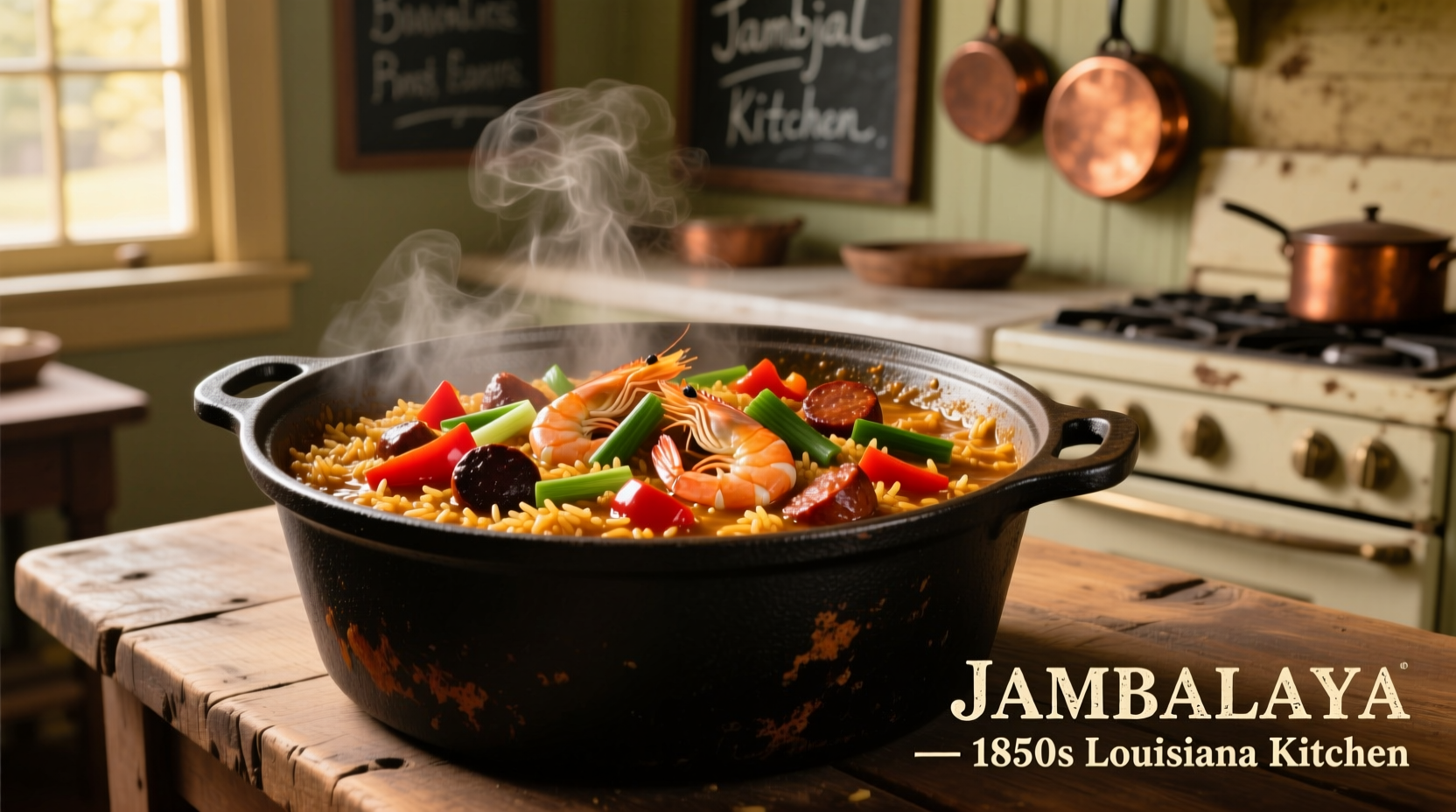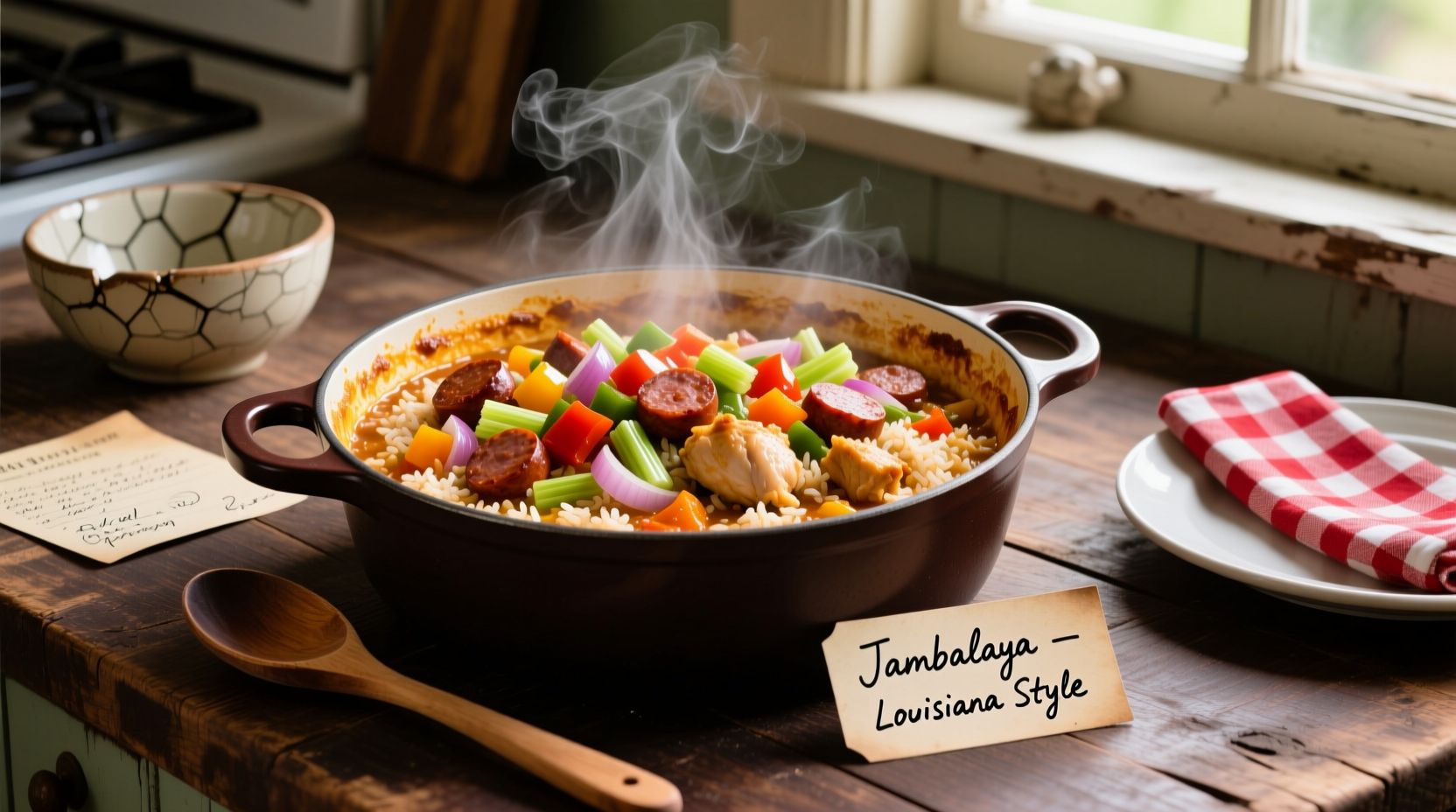Master authentic jambalaya in 45 minutes with this step-by-step guide. You'll learn the essential 'holy trinity' base, proper rice technique, and how to balance smoky andouille sausage with tender chicken for a flavorful one-pot meal that serves 6.
If you've ever wondered how to cook jambalaya that captures the true spirit of Louisiana cooking, you're in the right place. This Cajun classic combines smoky meats, aromatic vegetables, and perfectly cooked rice in a single pot. Forget dry, overcooked versions - our method delivers tender proteins and fluffy rice every time, honoring the dish's rich cultural heritage while adapting for modern home kitchens.
The Story Behind Authentic Jambalaya
Jambalaya's journey reflects America's cultural melting pot. Originating in 18th century Louisiana, this dish evolved from Spanish paella meeting French culinary techniques and African rice traditions. According to the Louisiana State University Digital Collections, early recipes appeared in handwritten cookbooks from Acadiana region households by the 1850s. The dish's name likely comes from the Provençal word 'jambalaia' meaning mixture, perfectly describing its 'everything but the kitchen sink' approach.
| Cajun Style | Creole Style |
|---|---|
| Rural origins (Acadiana) | Urban origins (New Orleans) |
| No tomatoes | Includes tomatoes |
| Darker roux | Lighter preparation |
| Wild game common | Seafood more prevalent |
Essential Ingredients Checklist
Authentic jambalaya relies on quality ingredients working in harmony. Don't skip the 'holy trinity' - the Cajun flavor foundation of equal parts onions, celery, and bell peppers. Here's what you'll need for perfect results:
- Proteins: 1 lb andouille sausage (smoked, not pre-cooked), 1 lb boneless chicken thighs
- Holy Trinity: 1 cup diced onions, 1 cup diced celery, 1 cup diced green bell peppers
- Aromatics: 4 garlic cloves minced, 2 bay leaves, 1 tsp dried thyme
- Liquid: 2 cups chicken stock (low sodium), 1 cup water
- Rice: 1½ cups long-grain white rice (not instant)
- Seasonings: 1 tsp smoked paprika, ½ tsp cayenne (adjust to taste), salt and black pepper

Your Jambalaya Cooking Timeline
Understanding the proper sequence prevents common mistakes. This isn't a dump-and-stir recipe - each step builds flavor:
- Prep (10 minutes): Dice all vegetables uniformly (¼ inch pieces). Slice sausage diagonally. Pat chicken dry.
- Sear proteins (8 minutes): Brown sausage first, then chicken. Remove both when browned but not cooked through.
- Soffritto base (10 minutes): Cook holy trinity until translucent (don't rush this step - flavor develops here).
- Layer flavors (2 minutes): Add garlic, thyme, paprika, and cayenne. Stir constantly.
- Simmer (15 minutes): Return meats to pot with stock, water, and rice. Bring to boil, then cover and reduce heat.
- Rest (10 minutes): Critical step! Let covered pot sit off heat before fluffing rice.
Avoid These 3 Common Jambalaya Mistakes
Even experienced cooks stumble with these pitfalls. Understanding context boundaries makes all the difference:
- Stirring during cooking: Unlike risotto, jambalaya rice needs undisturbed steaming. Stirring releases starch causing mushiness. Only fluff with fork after resting.
- Incorrect liquid ratio: The 1:1.5 rice-to-liquid ratio works only when using pre-browned meats that release fat. Using pre-cooked meats requires reducing liquid by ¼ cup.
- Rushing the soffritto: The holy trinity needs full 10 minutes to sweeten properly. High heat creates bitterness instead of the characteristic flavor base.
Serving and Storage Tips
Authentic jambalaya continues developing flavor as it rests. For best results:
- Let cooked jambalaya sit covered for 10 minutes before serving - this allows rice to absorb remaining moisture
- Serve in wide, shallow bowls to showcase the colorful ingredients
- Garnish with sliced green onions and fresh parsley just before serving
- Store leftovers in airtight container for up to 4 days - flavors improve overnight
- Reheat with 1-2 tablespoons water to restore moisture
Adapting for Your Kitchen
While traditional jambalaya uses chicken and andouille, the dish welcomes thoughtful variations. The Smithsonian's American Food: A History notes how resourceful cooks have always adapted based on available ingredients. Try these authentic-inspired options:
- Seafood version: Replace chicken with 1 lb shrimp added during last 5 minutes of cooking
- Vegan option: Use smoked tofu and vegan sausage with smoked paprika for depth
- Spice control: Remove cayenne entirely and serve with hot sauce on side for customization
Why This Method Works
The secret to perfect jambalaya lies in understanding how ingredients interact. According to culinary science research from the Culinary Institute of America, the fat rendered from properly browned andouille creates a flavor carrier that infuses the entire dish. The resting period after cooking allows starches to stabilize, preventing that dreaded mushy texture. This technique respects both tradition and food science - delivering restaurant-quality results in your home kitchen.











 浙公网安备
33010002000092号
浙公网安备
33010002000092号 浙B2-20120091-4
浙B2-20120091-4